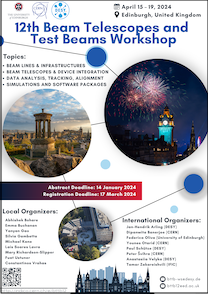Speaker
Description
PIONEER is a next-generation experiment proposed at the Paul Scherrer Institute to perform high precision measurements of rare pion decays. By improving the precision on the charged-pion branching ratio to electrons vs. muons and the pion beta decay by an order of magnitude, PIONEER will provide a pristine test of Lepton Flavour Universality and the Cabibbo angle anomaly. In addition, various exotic rare decays involving sterile neutrinos and axions will be searched for with unprecedented sensitivity.
The experiment design benefits from experience with the PIENU and PEN experiments at TRIUMF and at PSI. Excellent energy and time resolutions, greatly increased calorimeter depth, high-speed detector and electronics response, large solid angle coverage, and complete event reconstruction are all critical aspects of the approach.
In the PIONEER experiment design, an intense pion beam is stopped in a segmented, instrumented (active) target (ATAR). The proposed technology for the ATAR is based on low-gain avalanche detectors (LGADs), which can provide precise spatial and temporal resolution for particle tracks and thus separate even very closely spaced decays and decay products. The proposed detector will also include a ~2π sr, 25-X0 (radiation length) electromagnetic calorimeter. Two alternative designs for the calorimeter - liquid Xe or LYSO:Ce crystal scintillators - are being explored. An additional cylindrical tracker surrounding the ATAR, based on micro-patterned gas detector technology (µ-RWELL), may be used to link the locations of pions stopping in the target to showers in the calorimeter.
This contribution will present results from several beam test campaigns aimed at the investigation of different aspects of the experiment setup: simulation and beam diagnostics of the PSI PiE5 charged pion beamline including temporal and energy distribution of $\pi^+$, $\mu^+$ and $e^+$ with a segmented scintillator + SiPM readout; response of silicon AC-LGAD sensors at the same beamline; tests of gain suppression for highly ionizing particles at the University of Washington CENPA Tandem accelerator; characterization of LYSO crystal calorimeter prototypes, as well as trigger and digitization systems at the PSI PiM1 beamline. The near-future plans for further test beam data analysis and next beam test studies will be outlined.
